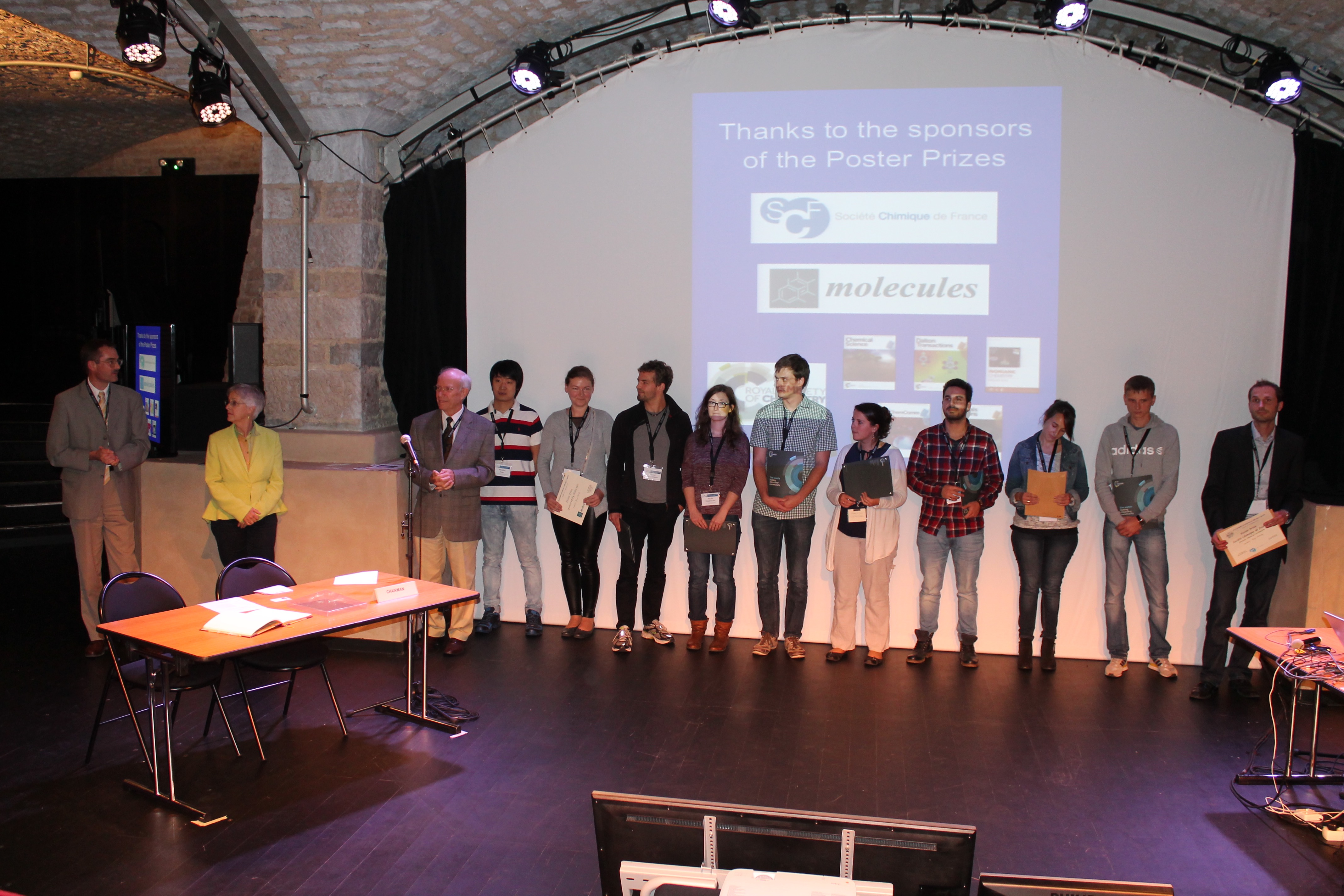| Sarit Agasti | Jawaharlal Nehru Centre for Advanced Scientific Research, India |
 |
Sarit received his Bachelor’s degree in Chemistry from the University of Calcutta, in 2003 and then his Master’s degree from the Indian Institute of Technology, Kanpur in 2005. Sarit went on to receive his PhD from the University of Massachusetts at Amherst under the supervision of Professor Vincent M. Rotello. Since his PhD, he has been a Postdoctoral Fellow at both the Massachusetts General hospital-Harvard Medical School and the Wyss Institute at Harvard University working with Professor Ralph Weissleder and Professor Peng Yin, respectively. Sarit has now returned to India and is working as a Faculty fellow at the Jawaharlal Nehru Centre for Advanced Scientific Research. His lab is interested in engineering small molecules and programmable molecular materials to address challenges in bioimaging, specifically in super-resolution microscopy. Some of his previously published work in Royal Society of Chemistry journals is below.
A photoactivatable drug–caged fluorophore conjugate allows direct quantification of intracellular drug transport Direct photopatterning of light-activated gold nanoparticles |
| Athina Anastasaki | Warwick University, UK |
 |
Athina received her Bachelor’s degree in Chemistry from the National and Kapodistrian University of Athens. She then undertook a PhD in Polymer Chemistry at the University of Warwick under the supervision of Professor David Haddleton. Athina is currently a Monash-Warwick Alliance Research Fellow in the research groups of Professor David Haddleton and Professor Thomas Davis, focusing on controlled living radical polymerization methods, mechanistic studies, photochemistry and sequence-controlled polymers. Some of her recently published work in Royal Society of Chemistry journals is below.
Photo-induced living radical polymerization of acrylates utilizing a discrete copper(II)–formate complex Photoinduced sequence-control via one pot living radical polymerization of acrylates |
| Read more » |
Pressure brings liquid marbles to a sticky end
Written by Emma Stephen for Chemistry World
Scientists in Japan have developed an adhesive that starts out as powder but transforms into glue for hard-to-reach places when pressed. This represents a promising application for liquid marble technology.
Liquid marbles are millimetre-sized liquid droplets that when coated in a hydrophobic powder, lose their wetness. Pressure-sensitive adhesives (PSAs) are viscoelastic polymers that instantly stick to solid surfaces through van der Waals forces. They are used in tapes, labels, post-it notes, spray droplets and adhesives, but PSAs’ sticky nature can make them difficult to handle. Combining these two technologies, Syuji Fujii and his team at the Osaka Institute of Technology in Japan and co-workers at the Max-Planck Institute for Polymer Research in Germany have developed liquid marbles made up of soft poly(n-butyl acrylate) latex polymer particles that form a tacky polymer core coated with a hard hydrophobic calcium carbonate nanoparticle shell. Initially, the marbles show no adhesive properties but by applying shear stress – light contact pressure between finger and thumb for 1–30 seconds – the powder’s nanoparticle layers rupture, allowing the soft inner polymer to ooze out, endowing the material with adhesive properties.
Interested? The full story can be read in Chemistry World.
The original article can be read below:
Pressure-sensitive adhesive powder
S Fujii et al, Mater. Horiz., 2016, Advance Article
DOI: 10.1039/C5MH00203F
Introducing the Materials Horizons Community Board
Materials Horizons is thrilled to announce that the first researchers have joined our Materials Horizons Community Board. This board is unique in that it is made up of early career researchers, such as PhD students and postdocs, that are fundamental in the future development of the materials field.
This board will help build relationships with the young researcher community, providing the editorial office with not only essential feedback and advice on the perception of the journal in their community but also education-focused initiatives that will benefit the materials community as a whole.
These engaged and enthusiastic researchers have been nominated by the Materials Horizons and Journal of Materials Chemistry A, B & C Editorial and Advisory Board. We received several excellent nominations and the successful candidates are:
- Sarit Agasti – Jawarhal Nehru Center for Advanced Scientific Research, India
- Athina Anastasaki – Warwick University, UK
- Robert Chapman – Imperial College London, UK
- Chaohua Cui – Soochow University, China
- Rebecca Gieseking – Northwestern University, USA
- Peter Korevaar – Harvard University, USA
- John Labram – University of California, Santa Barbara, USA
- Tian-Yi Ma – University of Adelaide, Australia
- Jaime Martín Pérez – Imperial College London, UK
- Troy Townsend – St Mary’s College of Maryland, USA
- Daiki Umeyama – Stanford University, USA
- Mengye Wang – Xiamen University, China
Please join us in congratulating the new members of the Materials Horizons Community Board.
Prize winners at 6th EuChemS conference on Nitrogen Ligands
Materials Horizons would like to congratulate the prize winners from the 6th EuChemS conference on Nitrogen Ligands which took place in Beaune, France from the 13th-17th September. A number of Royal Society of Chemistry journal prizes – including Materials Horizons – were awarded to the following attendees for their work:
- MedChemComm: Sophie Laine (CNRS, France)
- Chemical Science: Neeladri Das (Patna University, India)
- Dalton Transactions: Nicole Kindermann (Goettingen, Germany), Florian Schendzielorz (Goettingen, Germany) & Charles Lochenie (Bayreuth, Germany)
- Inorganic Chemistry Frontiers: Amandine Conte-Daban (LCC Toulouse, France) & Yasin Kuzu (Dortmund, Germany)
- Materials Horizons: Maxim A. Faraonov (Chernogolovka, Russia)
Previous conferences have been held in Alghero (1992), Como (1996), Camerino (2004), Garmisch-Partenkirchen (2008) and Granada (2011) with the intention of attracting scientists with an interest in the field of metal-nitrogen ligand chemistry from Europe, abroad and in particular, young scientists.
Further information about the conference can be found on the website.
Active and Adaptive Materials
October 22nd and 23rd 2015, ASRC
This two-day symposium will focus on active and adaptive nanomaterials on October 22nd and 23rd, 2015 at CUNY’s Advanced Science Research Center. In addition to presentations from Internationally-recognized leaders in nano-molecular chemistry, there will be contributed talks, tours of the facility and a poster session in the ground floor lobby.
Confirmed Speakers:
Samuel I. Stupp – Northwestern University
Joanna Aizenberg – Harvard University
Lee Cronin – University of Glasgow
Jan van Esch – Delft University of Technology
David G. Lynn – Emory University
Elisa Riedo – CUNY Advanced Science Research Center & The City College of New York
Nathan Gianneschi – UC San Diego
Adam Braunschweig – University of Miami
Shrinking hydrogel reinforces fabric for soft yet strong material
Written for Chemistry World by Carolyn Devlin
A hydrogel–fabric composite that can support a load almost three times greater than the fabric alone has been made by scientists in Japan and the US.
For many applications, an ongoing challenge is to develop materials with seemingly contradictory properties. For example, the biomedical field wants materials that are tough, yet soft, wet, flexible and biocompatible – quite a tall order. Many researchers have spotted the potential of hydrogels, which are known for being soft and biocompatible, but limited by their lack of strength.
Interested? The full story can be read in Chemistry World.
The original article can be read below:
Extremely tough composites from fabric reinforced polyampholyte hydrogels
Alfred J. Crosby and Jian Ping Gong et al.
Mater. Horiz., 2015, Advance Article
DOI: 10.1039/C5MH00127G
Bruno Chaudret is our new Scientific Editor

Materials Horizons would like to welcome Bruno Chaudret as our newest Scientific Editor.
Bruno has a wealth of experience having co-authored over 400 publications and being the recipient of several prizes including the Gay-Lussac – Humboldt Prize and the Wilkinson Prize of the RSC. He graduated from École Nationale Supérieure de Chimie de Paris in 1975 and then went on to receive his Ph.D. from Imperial College London in 1977 with Sir Geoffrey Wilkinson. He was awarded the degree of a “Docteur ès Sciences” at the University of Toulouse in 1979.
He is now “Director of Research CNRS”, Director of the “Laboratoire de Physique et Chimie des Nano-Objets” in Toulouse and a member of the French Academy of Science since 2005.
His interests have been in the chemistry of hydride and dihydrogen organometallic complexes, and in the early 90s, he developed an organometallic method for the synthesis of metal or metal oxide nanoparticles.
We very much look forward to working with him!
Poster prize winners at FPi-12
Big congratulations to the poster prize winners at the 12th International Symposium on Functional π-Electron Systems (Fπ-12) which took place in Washington, USA from the 19th – 24th July.
Matthias Stolte (Universitat Wurzburg, Germany) and Amir Mazaheripour (UC Irvine) were awarded first place poster prizes sponsored by Materials Horizons and Journal of Materials Chemistry A, whilst the runner up prizes were sponsored by Materials Horizons, Journal of Materials Chemistry B and Journal of Materials Chemistry C. These were presented to: Sahika Inal (CMP-EMSE, France), Nathan Kirchhofer (UCSB), Ana Fokina (Johannes Gutenberg-Universitat Mainz) and Suhyun Jung (Gwangju Institute of Science and Technology). Titles of their winning posters can be found here.
The symposium regularly attracts world-wide participants who meet to discuss their new achievements in research fields. Another symposium, scheduled for 2017 will take place in Hong Kong and will be titled Fπ-13. Further information about the symposium including the program and speakers from this year can be found by clicking here.
Poster prize winners at FPi-12 standing with Christine Luscombe (far right) who is the Associate Editor for Journal of Materials Chemistry A
Nano-accordions stretch the boundaries for flexible electronics
Written by Suzanne Howson for Chemistry World
Flexible products are becoming more desirable as smart technologies improve and develop. Many previously discovered conductive materials are opaque and cannot be stretched due to their planar structures. Finding materials that are conductive, stretchable and transparent is therefore of utmost importance to allow these technologies to advance.
Interested? Read the full story at Chemistry World.

Aluminium-doped zinc oxide is conductive, transparent and bendy when it has a corrugated structure
The original article can be read below:
Multifunctional nano-accordion structures for stretchable transparent conductors
Abhijeet Bagal, Erinn C. Dandley, Junjie Zhao, Xu A. Zhang, Christopher J. Oldham, Gregory N. Parsons and Chih-Hao Chang
Mater. Horiz., 2015, Advance Article
DOI: 10.1039/C5MH00070J
Materials Horizons First Immediacy Index
Materials Horizons, the new home for rapid reports of exceptional significance on innovative materials, has received its first immediacy index from Thomson Reuters’ Journal Citation Reports® (JCR).
Immediacy Index – 3.324
This puts Materials Horizons straight into the top 5 immediacy-indexed journals publishing primary research in the Materials Science, Multidisciplinary JCR category.
We are delighted that our authors’ work is being received and cited so well by the community and would like to thank all of our authors, referees and Board members for their support of this new journal.
Submit your next high impact paper to Materials Horizons and enjoy all of the benefits of being a Royal Society of Chemistry author!













